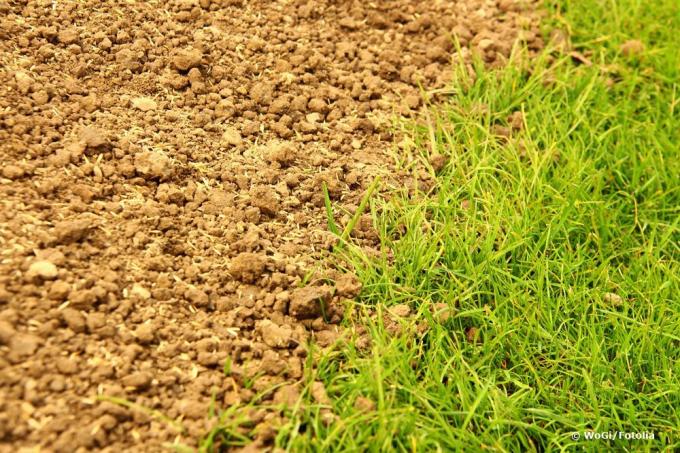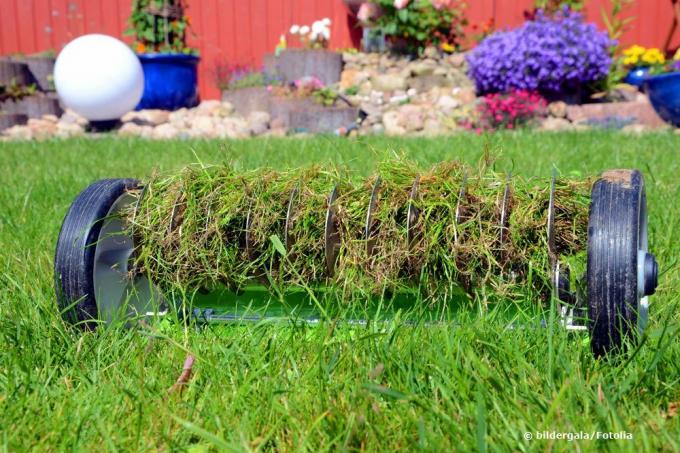
table of contents
- Spread topsoil on old lawn
- time
- Materials and tools
- preparation
- Spreading topsoil on old lawn: instructions
they have one racewho is a bit older and worn out? Then put your trust in topsoil. The mineral and nutrient-rich soil can help old lawns regain their fullness and ideally you only have to remove them from your own property. In doing so, you make use of the properties of the mother earth, which has proven to be an excellent rejuvenation cure for stressed and old lawns.
Spread topsoil on old lawn
An old lawn is no longer an ideal area. It does not matter whether the grass area is no longer as vigorous as it used to be and needs to be refreshed due to lack of care or years of use. Fortunately, there are a number of different methods that can be used to bring the green back to life. One of them is the use of nutrient-rich mother earth, which is applied as a layer and then provided with new seeds. However, with this idea, many people ask themselves the following questions:
- Does waterlogging develop?
- What about weeds?
Waterlogging is usually not a problem with this variant. Since you don't put ten or eight centimeters of mother soil, the old lawn can still breathe and the moisture is distributed perfectly in the soil. It is the same with weeds. This rots together with the remaining grass and thus provides a layer of humus, which also releases nutrients to the mother earth. To achieve these effects, how you land the soil is important, as you cannot just cover the lawn and leave it alone afterwards.
Note: In the same way, uneven areas in the lawn can be filled in, if you do not want to completely remove it. Since topsoil contains a lot of nutrients, the repaired areas will sprout again within a short time and the area will close.
time
One of the most important aspects of this method is timing. If you want to freshen up old turf with topsoil, you need to cover it at the right time to allow the greatest effect. There are only two possible time frames, as these favor the germination of the lawn seeds:
- April to May
- August to September
A constant temperature of 10 ° C is important, because below this the seeds will not germinate. Since you have two periods of time, you can choose when to distribute the mother earth. Note, however, that you will have to wait at least a full year afterwards until a dense area of grass has formed. Since you are completely re-laying the green, the waiting time is correspondingly long. In addition, you are only allowed to use the area for the entire period rarely enteras too much pressure could affect germination and growth. Choose a dry or overcast day. When it rains, the mother earth becomes too heavy to transport and the soil can suffer when it is exposed to intense sunlight.
Note: If you no longer want to use the covered green area as an ornamental or useful lawn, but rather for growing vegetables, for example, you don't have to wait that long. Since the topsoil is still very soft immediately after it has been applied, you should be very careful not to remove everything immediately.
Materials and tools
At first glance, it sounds quite easy to distribute mother earth on the old green and make it usable again. But the effort is much more extensive, because you need a good mother earth basis offer to establish yourself. And for this purpose you need the appropriate tools and materials that will assist you with this project. The following list gives you an overview of these:
- wheelbarrow
- mowing machine
- shovel
- Scarifier
- Rake
- Tape measure or folding rule
- Spirit level
- line
- Wooden sticks
- rake
- Long-term fertilizer (lime, iron sulfate)
- optional: lawn seeds

Most important, of course, is mother earth. This is the first eight to thirty centimeters of soil on which the sward is located. That is, you can use this soil to obtain topsoil with which to cover the lawn. You should not dig any further soil deeper, as it becomes more and more nutrient-poor and hardly any more Microorganisms that have a positive effect on the growth of the grass and the formation of humus would. So take enough mother earth from a spot in your garden to cover the entire area. How much you need depends of course on the area you want to cover. For this you just need to calculate the volume using the following formula:
Width in m x length in m x height in m = volume in m³
The width and length can of course be found on your lawn. For the height of the layer, around five centimeters are recommended, as these weeds and grasses rot and can be easily planted and polluted. For a lawn area of five by five meters, the calculation would look like this:
5 m x 5 m x 0.05 m = 1.25 m³
So you need 1.25 m³ of mother earth for such an area. In most cases, however, this direct information is not sufficient, as it may be that your lawn is uneven or even has holes. For this reason, you should always take 15 to 20 percent more as a precaution, just to be on the safe side. At 1.25 m³ that would be 1.44 m³ to 1.5 m³ of earth. You should always use a little more, especially with inclinations, as these are difficult to compensate.
If you do not have a scarifier available, you can rent one. Depending on the provider, you have to consider the following costs per day:
- Hardware store: around 30 euros
- Manufacturer: around 50 euros
- private: 10 to 35 euros
In themselves, the devices are not that expensive and can be obtained cheaply on the Internet. You can also use alternatives like a hand scarifier or special footwear, which will still make the job a little easier.
tip: If you don't have the option of using mother earth from your garden yourself, you can at affordable prices or sometimes even get it for free through the local classifieds. Many people can no longer do anything with their topsoil and for this reason offer the earth from which you will only benefit.
preparation
Before you can cover the lawn with topsoil, you need to do some prep in order to end up with a level and clean floor. It is particularly important to set out the height to enable a flat surface. To do this, simply mark the area with pieces of wood and stretch the cord between these at a height of five centimeters. Align them with a spirit level to get the same height in all places. Even if the area is on a slope, it is worth using the height as a guide. Once the height has been staked out, you need to prepare the ground:
- First use the lawn mower and mow the area thoroughly. This makes it easier to spread the mother earth, as stalks that are too tall would mess up the desired height. It is best to dispose of the grass residues on the compost so that they do not stay where they are and form another layer that has to be decomposed.
- Now you need to use the scarifier for the entire area. This removes unwanted plants or organisms such as mosses that tend to settle in the lawn. At the same time, the device loosens the soil, which will have a positive effect on further development.
With these points nothing stands in the way of the actual project. Below you will find detailed instructions that will detail all the steps you need to take.
Spreading topsoil on old lawn: instructions
Double check that you have enough topsoil available. It is important to proceed very carefully with all steps, because only in this way the topsoil layer is well preserved and can no longer be removed so easily. Proceed as follows:
- The topsoil is not immediately used up on the mown and scarified surface. You have to mix this with sand beforehand if your garden has always had a problem with waterlogging. The sand regulates the permeability of the soil, which is ideal for this purpose.
- Take the fertilizer and spread it generously on the old lawn. Work this in a little with the rake so that it is better distributed.
- Now the topsoil is finally being spread out on the old earth. To do this, you take the shovel and make sure that the entire area is covered with new earth. Once all of the mother earth is spread out, use the string to check the height of the layer. Use the spirit level for this if you have one available.
- Last but not least, you can plant seeds for a new lawn. The soil is moistened and monitored over the next few weeks. You just have to be careful not to let them dry out completely.





